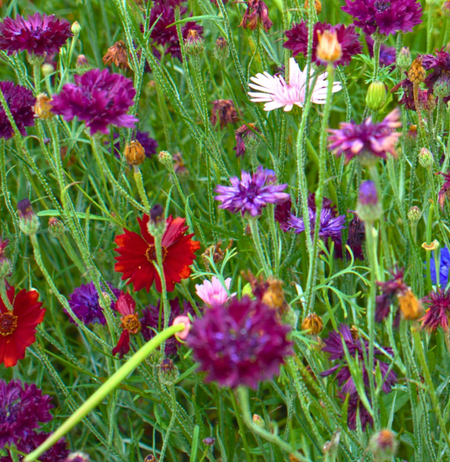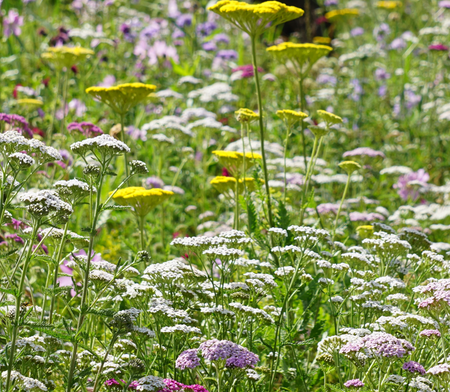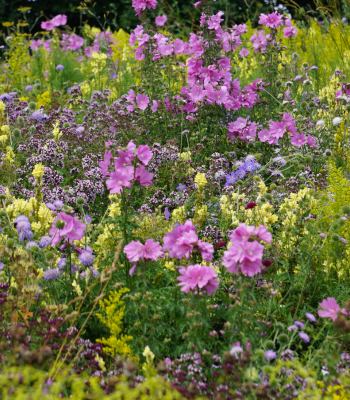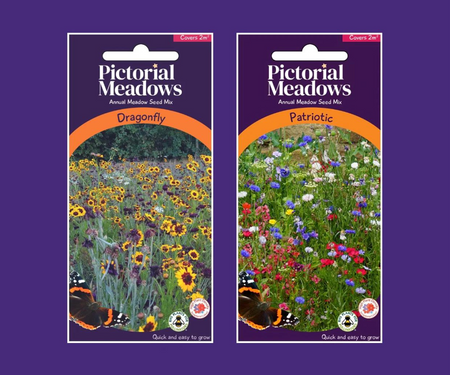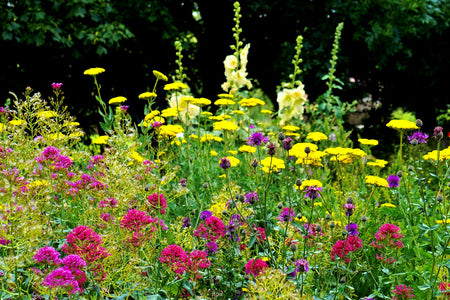Can I sow an annual meadow in the Autumn?
Yes, but it is not advised as you can expect to lose most if not all of the new seedlings during the winter. The remaining un-germinated seeds will grow earlier in spring and will provide a sparser display in the spring and summer.
Can I mix the annual seed with perennial seed?
No. If you are trying to establish a proper perennial meadow then do not put annual seeds with the mix. Annuals will very quickly out compete the slower perennials and create bare patches later in the season which will encourage weed infestation.
Can I mix the seed with grass to make it go further?
No. Grass is very competitive and will quickly dominate. If you want to make the mix go further you are better to decrease the sowing rate – but keep the edges close to the paths at the normal rate if you can.
What happens if I sow less or more than the recommended rate?
It’s best to stick to the 2 to 3 grams a metre rule, as that’s how we’ve formulated the meadow designs, but don’t worry too much either way. 3 grams and you will get a thicker, more boisterous display. It will probably look amazing early on, but be a bit too competitive for a fantastic late display. Exactly the opposite if you’ve gone down to 1 gram. It might look very sparse to start with but often this is compensated by each individual plant growing much bigger and some amazing late season meadows.
If I've sown an annual meadow one year, will it grow again the next year?
No, not really. Many species won’t reseed at all. Some species will, but in a much more random and patchy way. If you have a fairly infertile soil though, or you have experienced very little weed infestation you can get some lovely second and third year displays taking place from the few species that do reseed.
Do I need to protect the seeds from birds, mice or squirrels?
No. We have sown meadows in areas that were afterwards visited by big flocks of birds, and in areas where mice and squirrels were particularly happy, and so were our meadows in the end.
What effect will the fertility of the soil have on my display?
Annual meadows thrive on normal to high fertility soils, making them perfect solutions for most gardens and parks. The richer the soil though, the taller and bushier the plants will be and the thinner and poorer the soil, the opposite will happen. Normally if you grow annual meadows on the same patch of ground for more than 3 years you will see the fertility start to decrease and the emerging meadows look finer and shorter. If you suspect that the soil is very rich, then it’s probably best to reduce the sowing rate a little. Equally if it’s very poor, either just enjoy the daintier display or increase the sowing rate a little.
My display has been looking great, but in the recent really hot and dry weather the display is starting to go over. Is there anything I can do?
Most years, the displays carry on with later taller flowers masking the shorter earlier ones. Sometimes it’s just a question of giving nature a little bit more time. Even if the later flowers are less showy, they will still have a lot of sparkle. If really looking tatty you can give them the ‘Chelsea chop’ which is a very high cut to knock off the seeding flower heads and stimulate a second flush of growth and flowers.
It looks like I have a blanket of flowers. Is there anything I can do?
Unfortunately this sometimes happens, but don’t panic. Wait until your weeds are about 150 mm (6 inches) tall and run your mower over the whole area on the highest cut. This checks the weeds and allows the slower growing meadow to come through.
Do I need to irrigate?
No, but it’s really important to roll or firm the seeds into the ground so the seedlings get enough moisture. The seeds will germinate readily, as soon as the soil is warm and moist enough.
Does the sowing time have an impact on the flowering time?
Every year is different. In general though, early sowings will mean your meadow will come into flower earlier. If the summer is very hot and dry they may finish earlier.
How early and how late can I safely sow annual seeds?
The best month is April, but you can sow early in March, as long as the ground feels workable, and as late as early June.
Can I sow my seed over existing grass?
No, grass will prevent your seeds from growing. You need to prepare a clean weed-free seed bed.

